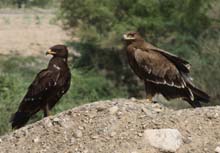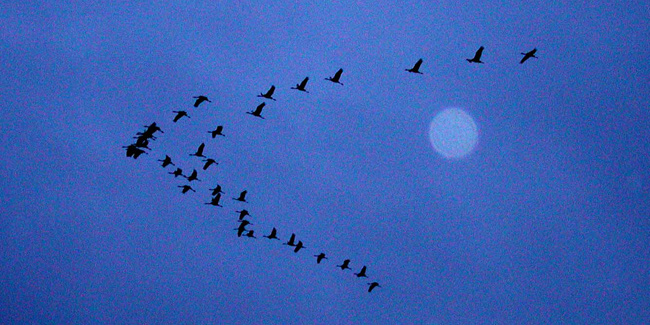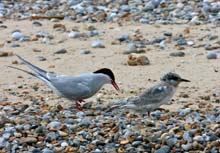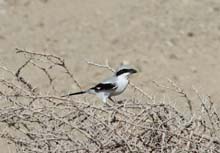| Migration…Just Think About It |
|
This article was originally published in Yemen Today magazine in May 2011 and written by David B. Stanton in consultation with Richard Porter
According to my father, “Only idiots run out of gas!” To avoid dad’s disdain I made sure that whenever I drove the tank dry he never found out. For migrating birds, on the other hand, “running out of gas” has serious, usually fatal consequences. If a migrating hummingbird doesn’t have enough fuel to cross the Gulf of Mexico, for example, it will drop like a feather to a watery grave. The hummingbird has little more substance than a ball of fluff; it weighs less than a 5 rial coin, yet it covers the 1,000 kilometers separating the tips of Florida and the Yucatan Peninsula in about 24 hours of constant flight. During this journey the hummingbird will flap its wings at least three times for each of its one and a half million heartbeats. A female Bar-tailed Godwit was recently tracked for nine days as she flew non-stop from New Zealand to Alaska, a distance of 11,500 kilometers, while carrying a satellite transmitter! Bar-headed Geese have been seen migrating over the highest Himalayan peaks honking exuberantly as their exhausted human observers sucked compressed oxygen from aluminum cylinders. Whether we struggle to climb a flight of stairs, are elite endurance athletes, or somewhere in between, we would do well to consider the feats accomplished by migrating birds, and all of us should take time to reflect on the many threats they face. Let us pause on May 14th and 15th for World Migratory Bird Day (WMBD) and ponder the wonders of migration. Perhaps 50 billion individuals representing half of the World’s 10,000 or so bird species migrate to and from their breeding areas. The The altitude that birds migrate at varies according to species but generally falls between 150 and 600 meters. The Bar-headed Geese mentioned earlier may exceed heights of 9,000 meters on their biannual migrations, but of course, not all migrants fly to their destinations. Some species of penguin migrate up to 1,000 kilometers by swimming. The Blue Grouse, a North American game bird that (unlike penguins) can fly, usually walks to and from its breeding grounds. Nocturnal migrants often navigate by the stars and many species apparently have celestial charts hardwired into their small brains. They may combine this with other navigational strategies to return to the exact nest or wintering site that they have used for their entire lives. Some use the Earth’s magnetic field as a guide, detecting it with molecular compasses in their brains or seeing it as White-eyes are believed to do. Others orient themselves according to the sun’s position, adjusting for latitude, season and time of day as they go. Some even use their sense of smell to help guide them on journeys that span continents and oceans. Navigation is apparently innate but is refined through learning. Veterans that have survived several migrations are known to migrate more directly than novices. With each passage birds learn to recognize landmarks along their routes and become better at adjusting for wind drift and other variables.
A few birds migrate singly but most choose to move in flocks, maintaining contact visually during the day and by calling at night. Small migrants find safety in numbers; as with schooling fish, the simultaneous movement of so many individuals may confound predators. Flocks of geese and cranes generally migrate in tight formation like cycling teams on the Tour-de-France. This saves up to 20% of their energy, allowing the birds to fly faster and further. As with cyclists, the leader will periodically move back in the formation to allow a fresher bird to blaze the route.
Hunting and trapping for food, fun, and profit kills many millions of migrants in the Mediterranean region alone. Every year an estimated 15 million birds are caught on Cyprus where they end up in cafes and kitchens. A further 3 million birds are said to be shot on Malta, an island less than one tenth the size of Socotra. According to British ornithologist Andrew Grieve, ‘When birds that cross the Mediterranean reach Egypt’s northern shore, they are greeted by a solid wall of nets.’ He estimates the loss in just this one country at over a hundred million birds every autumn. Richard Porter, advisor to BirdLife International’s Middle East program, believes that migrant mortality in Arabia and the Levant is equally high.
Another serious threat faced by migrating birds is posed by habitat destruction. Wetlands and forests are places where countless migrants rest and refuel, and many species depend on complex networks of traditional sites that they have used for generations. This is the theme World Migratory Bird Day 2011, which is titled, “Land use changes from a bird’s eye view.” According to the WMBD announcement, “Every year, more and more of the sites migratory birds need during their journeys either diminish or disappear completely. The majority of damage is caused by human use of land and has a direct impact on migratory bird populations, which are particularly sensitive to any interference to the sites they use throughout their migratory cycle.” Humans once believed that nature was inexhaustible. We should now know better. The great migrating flocks of Passenger Pigeons that darkened the sky for hours in the mid-19th Century had been hunted to extinction by the beginning of the 20th. We think that we have matured since this age of greed and shortsightedness, but the extinction of the Passenger Pigeon is symptomatic of behavior that persists until today. Because we fail to cherish our fellow Earthlings or anticipate the consequences of our actions, the Slender-billed Curlew may already be gone, Arabia’s Bald Ibises are on their way out, and the Spoon-billed Sandpiper is declining rapidly, just to name a few. Were my father alive today, he might voice a gentler opinion of those who occasionally forget to fill up - after all, we have consumed most of the World’s oil in the 20 years since his death. No doubt, “big oil” will find alternative technologies to keep us moving and its shareholders happy. Unfortunately, for many migrating birds, running out of gas may be their only option. For more information about World Migratory Bird Day May 14 – 15, 2011 visit www.worldmigratorybirdday.org a joint production of the AEWA (African Eurasian Waterbird Agreement) and the CMS (Convention of Migratory Species) Secretariats. Acknowledgement: Many thanks to Richard Porter for numerous helpful suggestions and for generously sharing some of his photos. |




 urge to migrate is usually brought on by changing day length that triggers hormonal adjustments leading to restlessness and insatiable hunger. In the days and weeks leading up to migration, birds may daily gain from 1 to 10% of their normal body weight in fat, the fuel that enables them to complete such stupendous journeys. Once they have approximately doubled their mass, they start moving. Storks and other soaring birds usually migrate during the day when updrafts, thermals, and predictable winds help them follow traditional flyways with the least expenditure of energy. Small birds such as warblers that must flap to stay aloft often migrate at night when they are less prone to predation and overheating. As they must refuel during the day they have few opportunities to sleep. Godwits, and other birds that remain airborne for days on end, face the same problem. Studies show that these birds may temporarily shut down their brains one hemisphere at a time in order to gain the rest they need to keep going.
urge to migrate is usually brought on by changing day length that triggers hormonal adjustments leading to restlessness and insatiable hunger. In the days and weeks leading up to migration, birds may daily gain from 1 to 10% of their normal body weight in fat, the fuel that enables them to complete such stupendous journeys. Once they have approximately doubled their mass, they start moving. Storks and other soaring birds usually migrate during the day when updrafts, thermals, and predictable winds help them follow traditional flyways with the least expenditure of energy. Small birds such as warblers that must flap to stay aloft often migrate at night when they are less prone to predation and overheating. As they must refuel during the day they have few opportunities to sleep. Godwits, and other birds that remain airborne for days on end, face the same problem. Studies show that these birds may temporarily shut down their brains one hemisphere at a time in order to gain the rest they need to keep going.
 The distance that birds migrate varies greatly depending on a variety of factors. Some, such as Yemen’s Arabian Accentor, may simply change altitude with the seasons, moving a few kilometers up and down slopes according to the time of year. Others cover truly heroic distances. The Arctic Tern, a delicate seabird that follows the midnight sun from Pole to Pole to Pole every year is said to be the longest distance migrant and to spend the highest proportion of its life in daylight of any bird. One Manx Shearwater, a long distance migrant that can live for 50 years, was calculated to have migrated a staggering eight million kilometers between hatching and death!
The distance that birds migrate varies greatly depending on a variety of factors. Some, such as Yemen’s Arabian Accentor, may simply change altitude with the seasons, moving a few kilometers up and down slopes according to the time of year. Others cover truly heroic distances. The Arctic Tern, a delicate seabird that follows the midnight sun from Pole to Pole to Pole every year is said to be the longest distance migrant and to spend the highest proportion of its life in daylight of any bird. One Manx Shearwater, a long distance migrant that can live for 50 years, was calculated to have migrated a staggering eight million kilometers between hatching and death! Trappers sometimes target specific migrants: falcons for sale to Gulf countries, shrikes to be rendered for fat, quails for the restaurant trade, but the technology they use is indiscriminate. “By catch,” birds for which there is no market, are simply discarded. Some hunters may also aim at specific birds, but others shoot everything in sight. For example, “Julia,” one of only five remaining wild Arabian Bald Ibises was shot while migrating through Saudi Arabia in 2009. So popular is hunting in the region that every year in Lebanon alone, hunters introduce up to 800 tons of lead into the environment one bullet and shotgun pellet at a time. This lead is an environmental time bomb that will continue to poison wildlife for centuries.
Trappers sometimes target specific migrants: falcons for sale to Gulf countries, shrikes to be rendered for fat, quails for the restaurant trade, but the technology they use is indiscriminate. “By catch,” birds for which there is no market, are simply discarded. Some hunters may also aim at specific birds, but others shoot everything in sight. For example, “Julia,” one of only five remaining wild Arabian Bald Ibises was shot while migrating through Saudi Arabia in 2009. So popular is hunting in the region that every year in Lebanon alone, hunters introduce up to 800 tons of lead into the environment one bullet and shotgun pellet at a time. This lead is an environmental time bomb that will continue to poison wildlife for centuries.